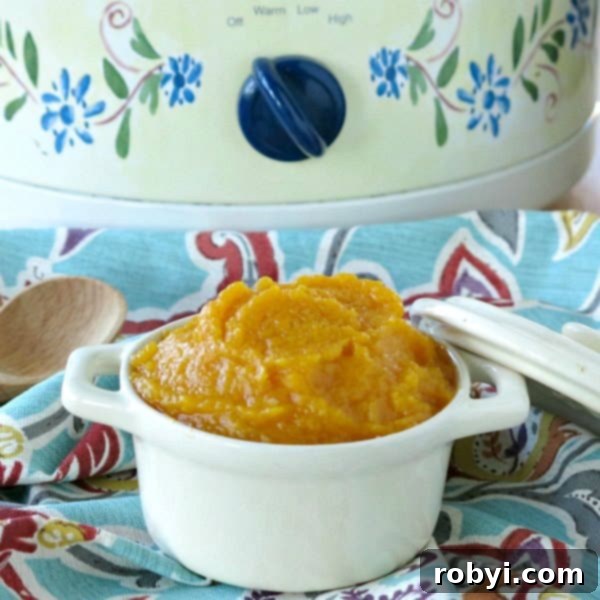How to Cook Whole Butternut Squash in a Slow Cooker: The Easiest No-Peel, No-Cut Method
Discover the ultimate hack for effortless butternut squash preparation! Learn how to cook whole butternut squash right in your slow cooker, eliminating the need for difficult peeling or cumbersome cutting. This incredibly simple method transforms a tough, stubborn gourd into silky, tender flesh with minimal effort, making it a perfect foundation for countless delicious recipes.
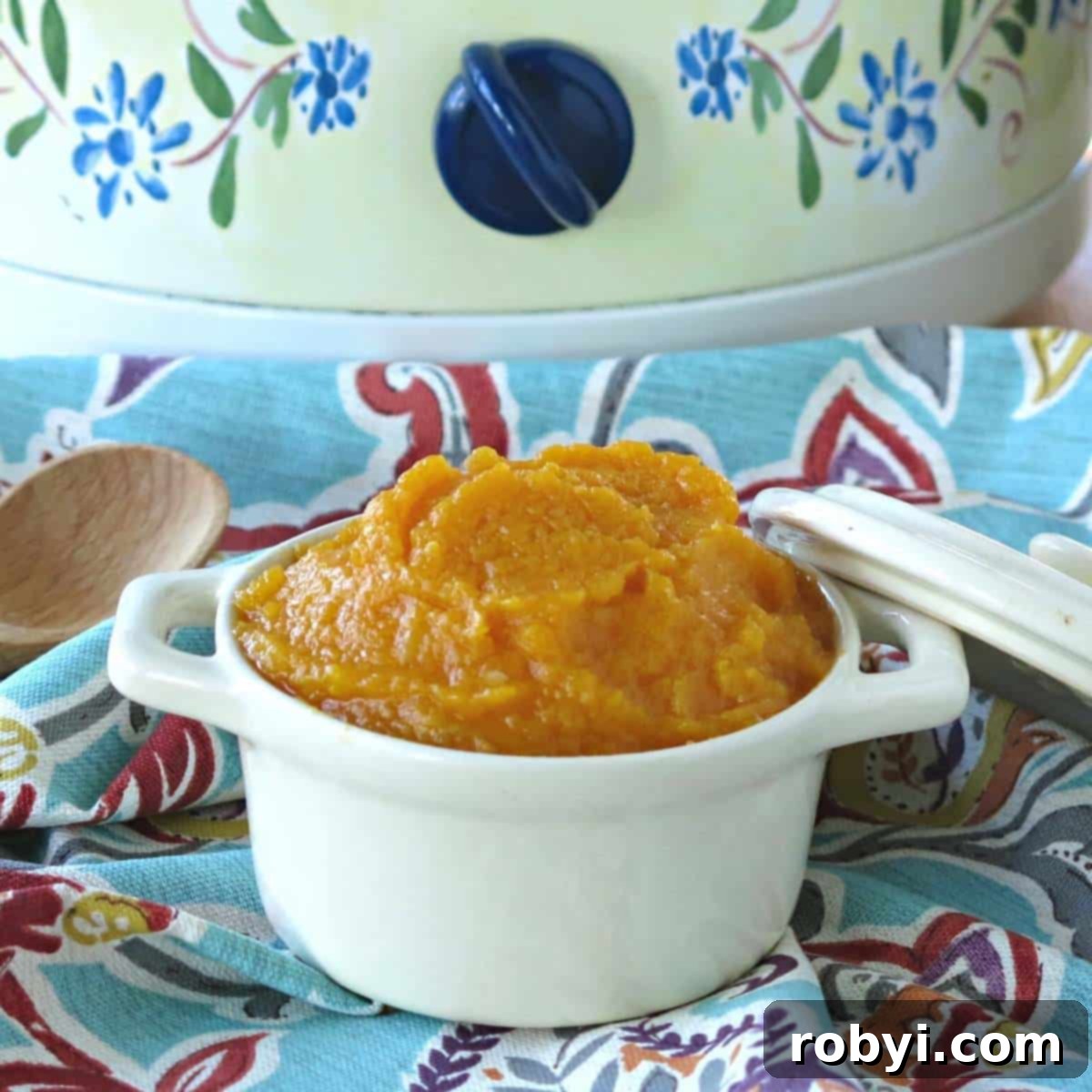
Imagine simply placing an entire butternut squash, skin, seeds and all, directly into your slow cooker. No more struggling with a sharp knife on a hard surface, risking injury, or wrestling with tough skin. This “set it and forget it” approach literally takes one minute of prep time, offering unparalleled convenience and safety in the kitchen. It’s a game-changer for anyone who loves the sweet, nutty flavor of butternut squash but dreads the prep work.
In our humble opinion, this is the superior method for cooking any hard-skinned winter squash, including popular varieties like spaghetti squash. The slow, gentle cooking process ensures consistently perfect results every time, yielding a creamy, soft texture that’s ideal for purees, soups, and more. Say goodbye to unevenly cooked squash and hello to culinary perfection!
This comprehensive guide will walk you through the simple slow cooker technique, provide expert tips for flawless results, and show you how to efficiently store your cooked butternut squash in the freezer. Stocking up on this versatile ingredient means you’ll always have it ready to whip up comforting fall recipes, like a rich and flavorful spicy butternut squash soup, creamy pasta sauces, or healthy baby food.
Why Choose the Slow Cooker Method? Unlocking Culinary Convenience
The slow cooker method isn’t just easy; it’s a revolutionary approach to preparing butternut squash that offers several compelling advantages:
- Unmatched Safety: The primary benefit is avoiding sharp knives and the potential for injury when trying to cut through a hard, round squash. With this method, your fingers are safe!
- Effortless Preparation: Seriously, the hands-on time is minimal. Just a quick rinse, and into the pot it goes. No peeling, no seeding, no chopping required before cooking.
- Perfectly Tender Texture: The moist, enclosed environment of a slow cooker ensures that the squash steams gently, resulting in incredibly tender, creamy flesh that practically melts off the skin.
- Flavor Enhancement: Slow cooking allows the natural sugars within the squash to caramelize and deepen, intensifying its inherent sweetness and rich, earthy flavor.
- Time-Saving: While the cook time is several hours, it’s entirely passive. You can attend to other tasks, run errands, or simply relax while your slow cooker does all the hard work.
- Versatility: Once cooked, the soft flesh is easily transformed into a smooth puree, ready for a wide array of sweet and savory dishes.
Selecting the Perfect Butternut Squash
For optimal results with the slow cooker method, choosing the right butternut squash is key. Here’s what to look for:
- Size Matters: The most crucial factor is ensuring your butternut squash fits comfortably inside your slow cooker. It’s best to select a squash that is slightly smaller than your crock-pot. While you can trim an end off if necessary, the beauty of this method lies in avoiding that step entirely. Aim for a squash that can sit flat or semi-flat with the lid fully closed.
- Firmness: A ripe butternut squash should feel heavy for its size and be very firm to the touch. Avoid any squash that feels soft or squishy, as this can indicate spoilage.
- Appearance: Look for a squash with a smooth, matte, and uniformly tan or beige skin. Minor imperfections are usually fine, but avoid squash with deep cuts, dark spots, or mold. The stem should be intact and firm.
- Color: A rich, deep tan color indicates ripeness. Green patches suggest the squash was picked too early and might not be as sweet or flavorful.
Ingredients
This recipe is incredibly minimalist, requiring just one star ingredient:
- One whole butternut squash, ensuring it’s appropriately sized for your slow cooker.
That’s it! No extra liquids, no oil, no seasonings needed for the cooking process itself. The magic happens with just the squash and your slow cooker.
Directions: Your Simple Guide to Slow Cooker Butternut Squash
The process of cooking whole butternut squash in a crock-pot is remarkably straightforward, yielding perfect results every time. Follow these easy steps:
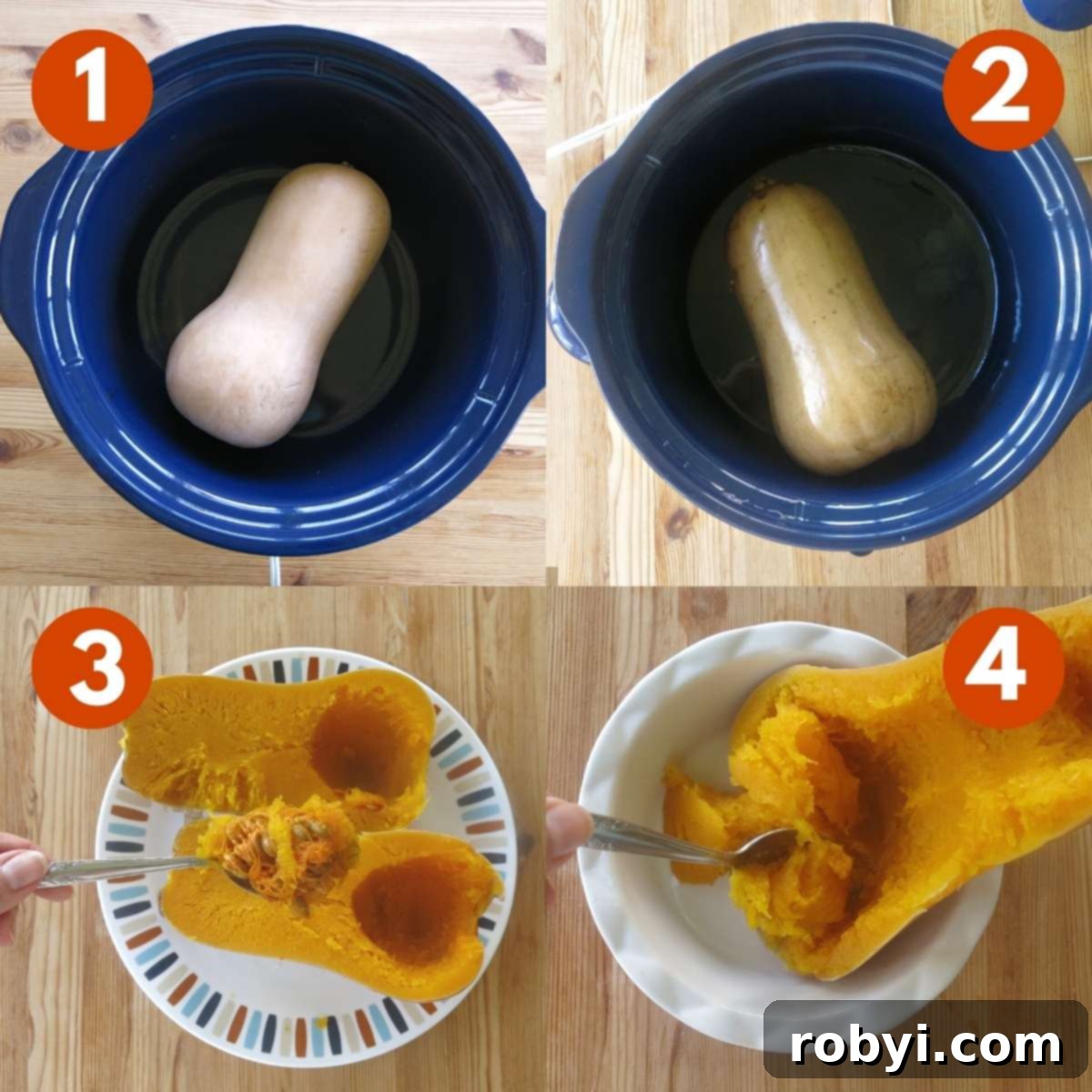
- Prepare the Squash: Begin by thoroughly rinsing the outside of your butternut squash under cool running water. Pat it dry with a clean cloth. There’s no need to poke holes or add water to the slow cooker.
- Place in Slow Cooker: Carefully place the cleaned, whole butternut squash inside your slow cooker. Ensure the lid can close tightly and securely.
- Cook to Perfection: Set your slow cooker to either high for 3-4 hours or low for 4-6 hours. The exact timing can vary slightly depending on the size of your squash and the specific model of your slow cooker. The squash is done when its outer skin is tender and can be easily pierced with a fork.
- Cool and Handle: Once cooked, turn off the slow cooker and allow the butternut squash to cool inside for at least 15-20 minutes. It will be extremely hot and soft, so cooling makes it much safer and easier to handle.
- Remove and Halve: Using oven mitts or a clean rag for protection, carefully lift the squash out of the slow cooker and transfer it to a cutting board. Slice the squash in half lengthwise with a sturdy knife.
- Scoop Seeds: Use a spoon to gently scoop out the seeds and any stringy bits from the center cavity. You can discard these or, if you’re feeling adventurous, roast the seeds for a tasty snack!
- Harvest the Flesh: With a spoon, gently scrape the soft, cooked flesh away from the skin. The flesh should come away easily, leaving the tough skin behind. Collect the creamy flesh in a bowl.
Expert Tips for Slow Cooker Butternut Squash Success
Based on years of experience and common questions, here are some invaluable tips to ensure your slow-cooked butternut squash is always perfect:
- Rinsing is Key: Always rinse the exterior of your butternut squash before cooking, just as you would any other fruit or vegetable, even though you won’t be eating the skin. This removes any dirt or surface contaminants.
- No Poking Necessary: Unlike some other cooking methods, there’s no need to poke holes in the butternut squash skin before slow cooking. The slow, moist heat prevents pressure from building up excessively. If you’re genuinely concerned, a few shallow stabs won’t hurt, but they are not required.
- Skip the Water: You do not need to add any water to the bottom of the crock-pot. Butternut squash naturally releases a small amount of liquid as it cooks, creating its own steaming environment. Always consult your slow cooker’s manual if it provides different instructions, but typically, no added liquid is needed for whole vegetables.
- How to Tell It’s Done: The definitive test for doneness is when a fork easily pierces the outer skin and sinks into the flesh. While it’s best to avoid repeatedly lifting the lid (which extends cook time), check at the minimum recommended time to gauge your appliance’s performance.
- Optimal Cook Time Range: Generally, cook butternut squash for approximately 3-4 hours on the high setting or 4-6 hours on the low setting. These times provide a good range for most squash sizes.
- Forgiving Cook Time: One of the beauties of slow cooking is its forgiving nature. An extra hour or even two will not negatively impact the final result; in fact, it often makes the squash even more tender and easier to work with.
- Allow for Cooling: Cooked butternut squash will be extremely hot and very soft right out of the slow cooker. Always turn off the appliance and allow it to cool for at least 10-20 minutes before attempting to handle it. This prevents burns and makes the squash firm enough to cut safely.
- Safe Removal: Use washable oven mitts or a pair of kitchen tongs to safely lift the hot, soft squash out of the crock-pot and transfer it to a sturdy plate or cutting board. Alternatively, consider using a slow cooker liner for even easier cleanup and removal.
- Cook Multiple Squash: If your slow cooker is large enough, you can cook more than one butternut squash at once, provided they fit without stacking. They should be in a single layer for even cooking.
- Yield Expectation: From a typical two-pound butternut squash, you can expect to yield approximately 3 cups of smooth, creamy puree.
Transforming Butternut Squash into Creamy Puree
Once you’ve scraped all the soft, cooked flesh from the skin, your butternut squash puree is essentially ready to use. The slow cooking method naturally creates a wonderfully smooth and creamy consistency that many find perfectly satisfying for most recipes.
However, if you desire an even silkier texture, or if you’re preparing natural baby food, you might want to take an extra step. Simply transfer the cooked squash flesh to a food processor and pulse until completely smooth. For an ultra-creamy, slightly thinner consistency, an immersion blender can also be used directly in the bowl. This step helps eliminate any tiny lumps and creates a consistently smooth product, ideal for delicate sauces or very young eaters.
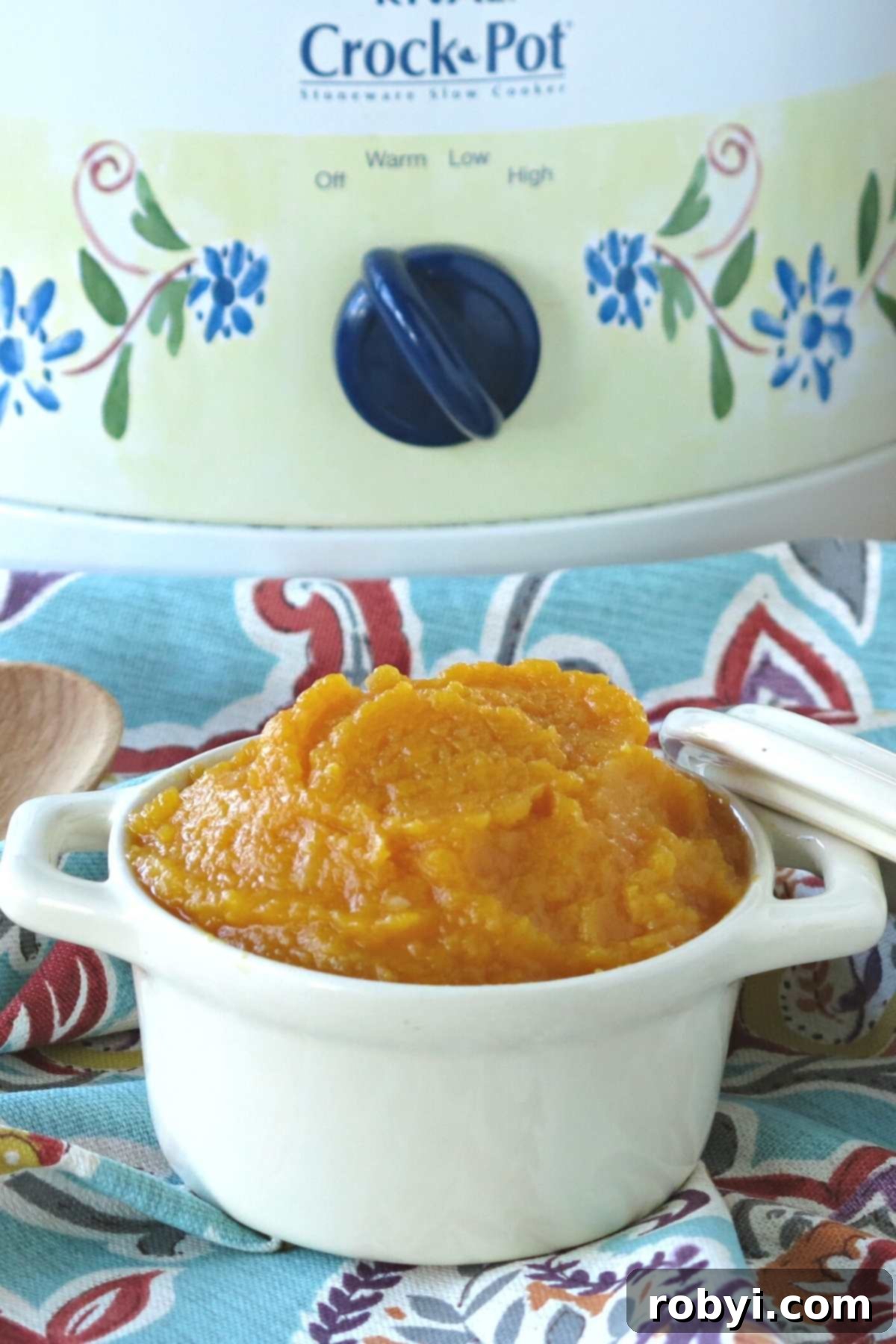
Storage Solutions for Cooked Butternut Squash
Having cooked butternut squash on hand is a huge time-saver for meal prep. Proper storage ensures its freshness and extends its usability:
- Refrigeration: Cooked butternut squash, whether mashed or pureed, will stay fresh in the refrigerator for approximately 3-5 days. To maintain its quality, transfer it to an airtight container or a sealed plastic bag. This prevents it from absorbing odors from other foods and keeps it from drying out. Interestingly, raw, peeled, and cubed butternut squash also maintains its freshness for about 5 days in the refrigerator when stored in a similar fashion.
How to Freeze Butternut Squash: Your Winter Harvest Secret Weapon
Freezing cooked butternut squash is an excellent way to preserve this seasonal delight and ensure you have it readily available for months. Properly frozen butternut squash puree is safe to eat for up to 6 months. However, for the very best taste, texture, and nutritional quality, we highly recommend using it within 2-3 months.
Freezing Methods:
The key to efficient freezing is portioning the puree into amounts you’re likely to use in future recipes. This makes thawing and cooking much more convenient.
- Muffin Tin Method (for individual portions): This is one of our favorite methods for creating perfectly sized portions. Fill the wells of a muffin tin (standard or mini, depending on your desired portion size – ½ cup is a common and versatile amount) with butternut squash puree. Place the muffin tin in the freezer until the puree is completely solid, typically 2-4 hours. Once frozen, pop out the solid blocks of puree.
- Plastic Containers or Freezer Bags: For larger quantities or if you don’t have muffin tins, you can freeze puree directly in airtight plastic freezer containers or heavy-duty freezer bags. If using bags, flatten them before freezing to save space and speed up thawing. Make sure to leave some headspace in containers, as liquids expand when frozen.

Thawing Frozen Butternut Squash:
- Overnight in the Refrigerator: The safest and most recommended way to thaw frozen butternut squash is to transfer it from the freezer to the refrigerator the night before you plan to use it.
- Microwave Thawing: For quicker thawing, you can use the microwave. The amount of time will depend on the size of your frozen portion. As a general guideline, a ½ cup portion of frozen butternut squash puree usually takes about 1-2 minutes on high to begin defrosting. Stir the puree and continue microwaving at 30-second intervals until it’s warmed through and pliable.
- Directly into Hot Dishes: Often, you can add frozen butternut squash puree directly into soups, stews, or sauces. It will thaw and incorporate as the dish heats up, adding flavor and thickness.
Once thawed, the puree might have a slightly thinner consistency due to ice crystal formation, but its flavor and nutritional value will remain intact.
Culinary Creations: Delicious Ways to Use Butternut Squash Puree
Once you’ve mastered cooking butternut squash in your crock-pot, a world of delicious fall and winter recipes becomes effortlessly accessible. The creamy, naturally sweet puree is incredibly versatile. Here are some inspiring ideas to put your homemade puree to excellent use:
- Hearty Soups and Stews: Butternut squash puree is the ideal base for rich and creamy soups. With your main ingredient prepped, most butternut squash soups can be finished in under 30 minutes. Try a classic roasted butternut squash soup, a spicy variation, or blend it into a hearty lentil stew for added richness and nutrients.
- Delectable Baked Goods: Replace pumpkin puree with butternut squash puree in virtually any baking recipe. Its similar texture and sweet flavor make it an excellent substitute in muffins, breads, pies, and even cookies. Imagine moist butternut squash muffins with apples and cinnamon, or a decadent butternut squash cheesecake.
- Savory Pasta Sauces: Transform your puree into a velvety pasta sauce that’s both nutritious and incredibly flavorful. A creamy butternut squash pasta sauce can be equally delightful tossed with noodles, spread as a base for pizza, layered in lasagna, or used in any recipe that traditionally calls for tomato-based spaghetti sauce.
- Wholesome Baby Food: Butternut squash is a fantastic first food for babies due to its smooth texture and abundance of vitamins. Simply puree the cooked flesh further if needed, adding a touch of water or breast milk/formula to achieve the desired consistency. Consult resources like Momtastic for expert tips on feeding babies squash.
- Comforting Mashed Butternut Squash: For a simple yet satisfying side dish, warm the puree, season it with a pinch of salt, pepper, and perhaps a touch of cinnamon or nutmeg, and serve it mashed with a swirl of butter or a drizzle of maple syrup. It’s a healthy alternative to mashed potatoes.
- Smoothies and Juices: Add a spoonful of cold butternut squash puree to your morning smoothie for an extra boost of vitamins and a lovely creamy texture. It pairs well with fruits like banana, apple, and spices like ginger.
- Curries and Indian Dishes: The subtle sweetness of butternut squash puree integrates beautifully into coconut-based curries, adding body and depth of flavor.
- Butternut Squash Risotto: Stir the puree into a creamy risotto for a vibrant, flavorful, and comforting main course.
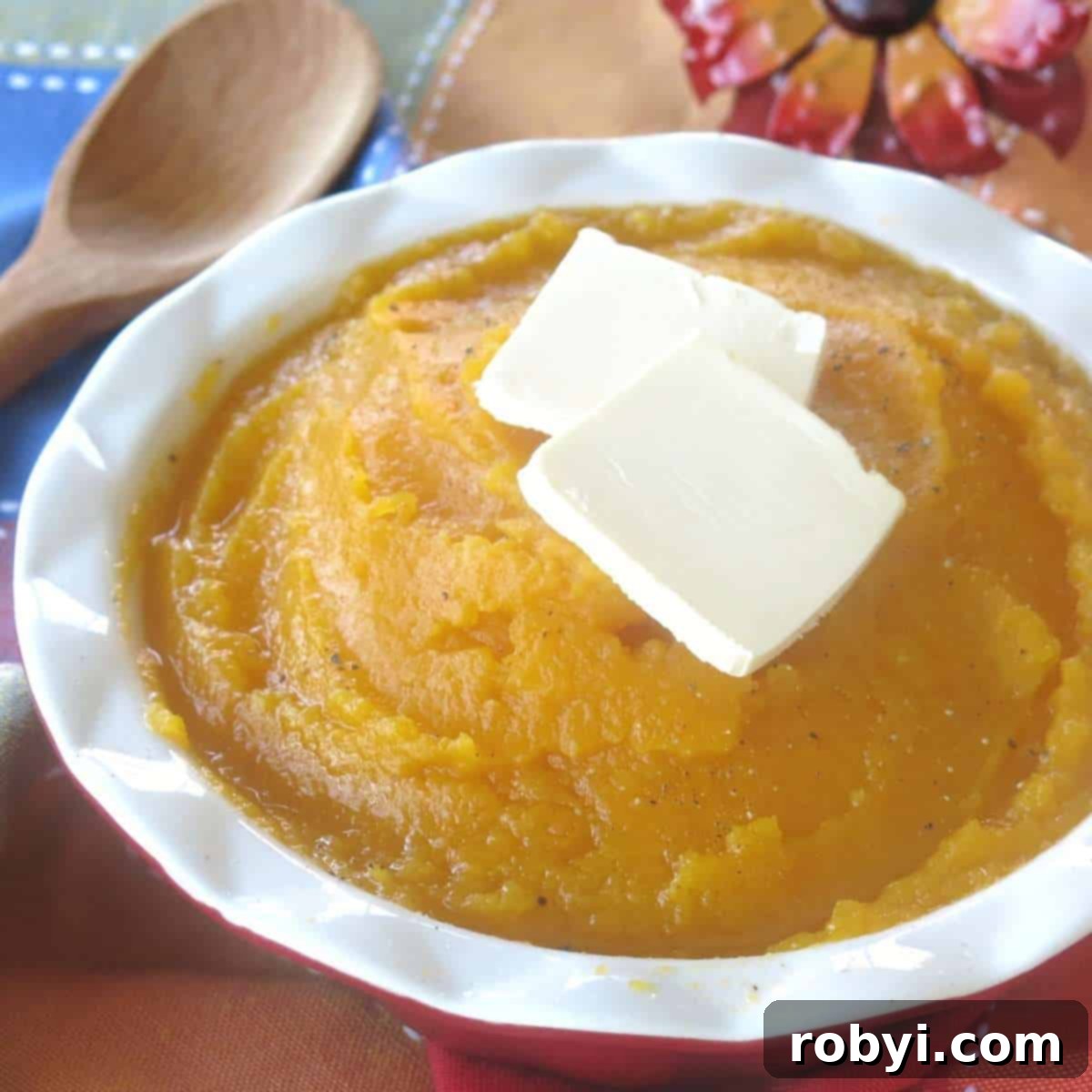
The Nutritional Powerhouse: Benefits of Butternut Squash
Beyond its delightful taste and versatility, butternut squash is a nutritional superstar. Incorporating it into your diet provides a wealth of health benefits:
- Rich in Vitamins: It’s an excellent source of Vitamin A (in the form of beta-carotene), which is crucial for vision, immune function, and skin health. It also provides a good amount of Vitamin C, an important antioxidant.
- High in Fiber: Butternut squash is packed with dietary fiber, which aids in digestion, promotes a feeling of fullness, and can help regulate blood sugar levels.
- Minerals Galore: This humble squash also offers essential minerals like potassium (important for blood pressure and heart health), magnesium, and manganese.
- Antioxidant Properties: The vibrant orange color of butternut squash is a sign of its high antioxidant content, which helps fight free radicals in the body and reduces inflammation.
- Low Calorie: Despite its rich flavor and satisfying texture, butternut squash is relatively low in calories, making it a healthy addition to any meal plan.
By cooking butternut squash whole in the slow cooker, you’re not only simplifying your kitchen routine but also making it easier to enjoy a nutritious and delicious vegetable year-round.
Explore More Delicious Squash Recipes
If you’ve enjoyed the simplicity and versatility of slow-cooked butternut squash, you’ll love these other fantastic squash-centric recipes that bring warmth and flavor to your table.
- Spicy Butternut Squash Soup Recipe with Apple
- Butternut Squash Muffins with Apples and Cinnamon
- Creamy Pumpkin Pasta Sauce Recipe
Would you like more easy, healthy, carb-conscious recipes?
📋 Recipe: How to Cook Whole Butternut Squash (Crock-Pot)
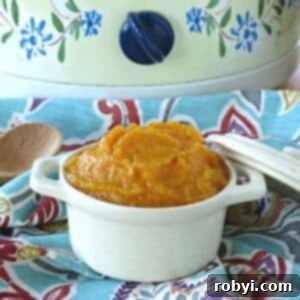
How to Cook Whole Butternut Squash (Crock-Pot)
Learn how to cook whole butternut squash in a crock-pot. Using a slow cooker is the easiest way to make it without peeling or cutting it first!
Rating: 5 out of 5 stars (from 5 votes)
Print Recipe | Pin Recipe | Rate This Recipe
Prep Time: 15 minutes | Cook Time: 4 hours | Resting: 9 minutes | Total Time: 4 hours 5 minutes
Servings: 6 servings | Author: Marjory Pilley
Save this recipe?
Enter your email & get this recipe sent to your inbox! Plus receive new recipes each week!
Enter your email here to get the recipe
Equipment
- Programmable Slow Cooker
Ingredients
- 2 pounds butternut squash (whole)
Instructions
- Wash the outside of the butternut squash thoroughly.
- Place the whole butternut squash in the slow cooker and cover with the lid.
- Cook on high for 3-4 hours or on low for 4-6 hours, or until a fork is easily inserted into the flesh.
- Allow the squash to cool for about 10-15 minutes, then carefully remove it from the crock using washable oven mitts.
- Cut the butternut squash in half lengthwise, then remove and discard the seeds and stringy bits.
- Scrape the soft flesh into a bowl and stir. If desired, use a food processor or immersion blender to achieve a thinner, smoother consistency.
- Season with salt and pepper to taste, enjoy immediately, use in another recipe, or freeze for later.
Last Step: Please leave a rating and comment! Letting us know how you liked this recipe helps our business thrive so we can continue to provide more free recipes!
Notes
Makes about 6 half-cup servings.
Be mindful of the size of the butternut squash compared to your slow cooker. If necessary, the tip of the butternut squash can be carefully cut off to allow it to fit, though the goal is to avoid cutting beforehand.
Grab 5 Low-Carb Sauces and get more easy, healthy recipes! JOIN HERE
Nutrition
Calories: 31kcal | Carbohydrates: 8g | Sodium: 2mg | Potassium: 246mg | Fiber: 1g | Sugar: 1g | Vitamin A: 7440IU | Vitamin C: 14.7mg | Calcium: 34mg | Iron: 0.5mg
Nutritional and Food Safety Disclaimer
This recipe was originally published on October 17, 2018, and has been thoroughly updated and expanded to enhance the reader experience and provide more comprehensive information.
